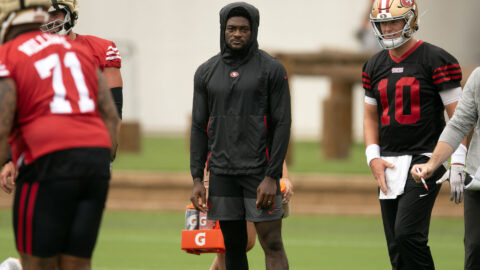Entering play on Tuesday, only one team in the American League — the Detroit Tigers — was getting fewer innings per game from its starters than the Boston Red Sox.
The starters in four of Boston's seven games have failed to last past the fifth inning and the team's rotation has averaged 5 2/3 innings pitched per outing.
Questions have surfaced surrounding the effectiveness, or lack thereof, of the rotation. Why does Jon Lester continue to struggle out of the gate (2-5, 5.08 ERA in March and April starts)? When will Josh Beckett have a good result against the Yankees (24 runs in his last 36 2/3 innings against the Bronx Bombers)? Has Clay Buchholz done enough to keep his spot, if and when the team has six health starters to play with (five unspectacular innings Sunday after an inconsistent spring)?
So long as this trend continues, the questions will eventually turn to the bullpen, which will be called upon to pick up the pieces and bridge massive gaps to the end of games. Few AL teams have used their bullpen more often than the Sox, whose relievers have shown cracks of their own, posting a collective 1-3 record with a 4.84 ERA.
The bullpen was considered a strength to start the season. Few teams can boast a back end of Jonathan Papelbon, Daniel Bard and Hideki Okajima. But can the group as a whole compare to the 2009 version, which ranked second in the AL with a 3.80 ERA and was one of the big reasons Boston could win 95 games with a patchwork rotation?
In a word, or two, not yet.
Until we see a little more, it is safe to assume Papelbon is Papelbon. He is 2-for-2 in save opportunities, but he did have the rough outing in a tie game against New York on Thursday.
Boston used several pitchers ahead of Papelbon last year. Takashi Saito was a set-up option much of the season but missed a chunk of time in September. Billy Wagner shined in 15 late-season games. Bard was electric before a few hiccups down the stretch.
The wealth of eighth-inning options was notable. But questions (there's that word again) could pop up for the 2010 group if Bard wears down as he did last year; even with others around to help serve as the bridge to Papelbon, the young righty had a 4.74 ERA after the All-Star break. And this year he is definitively the man in that role, appearing in five of the team's first six games.
Having someone like Saito or Wagner around might be necessary if that rate continues.
Until Okajima can show he can get out righties, a major issue in 2009 when they hit .309 off him, the jury is out on the lefty's effectiveness in 2010. Ramon Ramirez, whose ERA increased every month last year, has a 33.75 mark thus far. There are major concerns surrounding his regression with the Red Sox.
While we await a larger sample size to judge those guys, there is one final role the club has yet to fill. Justin Masterson was the one guy Terry Francona could rely on for extended innings out of the 'pen last year, a critical role on a team that had a 5.89 ERA in the fifth inning, when many starts ended prematurely. Masterson threw two or more innings in relief 11 times.
The lack of a true long man was notable right off the bat in 2010.
In the first series at Fenway Park, the Yankees won a pair of bullpen battles when Alfredo Aceves threw two scoreless innings in relief during Tuesday's 6-4 win over the Sox, and Chan Ho Park went three scoreless in Wednesday's 3-1 decision.
No Boston relievers threw more than 1 1/3 innings in the series, and two of the three that lasted that long got hit hard in their second inning of work.
Manny Delcarmen is apparently being groomed for an extended role. He threw multiple innings several times during the spring and did so again Sunday in Kansas City, working two scoreless frames (he lasted two innings just three times in 2009). In the two-inning outing, his velocity was up, a great sign for a club praying that Delcarmen's shoulder woes are a thing of the past.
Delcarmen's ability to adapt to that role will be critical going forward. Having Masterson-type flexibility looms large, especially in times when the starters are struggling to get past the fifth.



